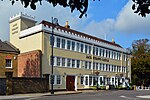Inverforth House

Inverforth House (formally known as The Hill) is a large detached house at North End Way on the outskirts of Hampstead in the London Borough of Camden, NW3. Owned by William Lever, 1st Viscount Leverhulme from 1904 to 1925, The Hill was bought by Andrew Weir, 1st Baron Inverforth after Leverhulme's death in 1925, and following was given to Manor House Hospital after Inverforth's death in 1956. Inverforth House was home to the Orthopaedic Society Hospital from the 1950s to the 1980s, and was converted into two houses and seven apartments in the late 1990s.Rebuilt in the British Queen Anne Revival style in 1895 by the architectural firm Grayson and Ould, it is a Grade II listed building. Built from red brick, Inverforth House has a steeply pitched roof. The architectural style of Inverforth House has been described as "Neo-Georgian" with "Queen Anne style wings".In 2002 English Heritage commemorated Viscount Leverhulme and geneticist and statistician Ronald Fisher, who lived there as a child from 1896 to 1904, with blue plaques.
Excerpt from the Wikipedia article Inverforth House (License: CC BY-SA 3.0, Authors, Images).Inverforth House
North End Way, London
Geographical coordinates (GPS) Address Website Nearby Places Show on map
Geographical coordinates (GPS)
| Latitude | Longitude |
|---|---|
| N 51.564833333333 ° | E -0.18095555555556 ° |
Address
Ronald Fisher
North End Way
NW3 7EU London (London Borough of Camden)
England, United Kingdom
Open on Google Maps











